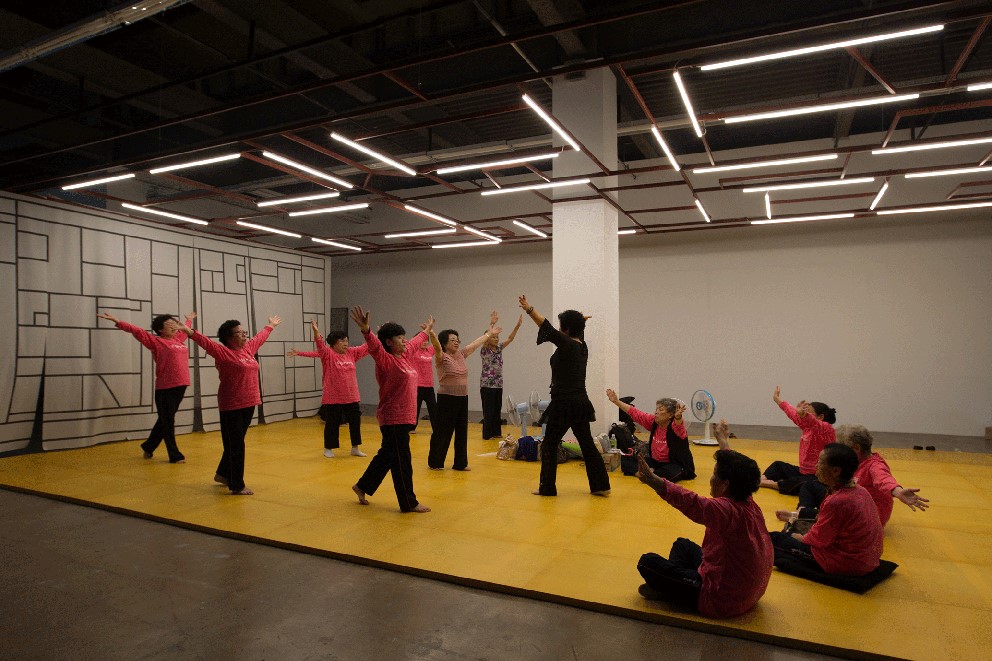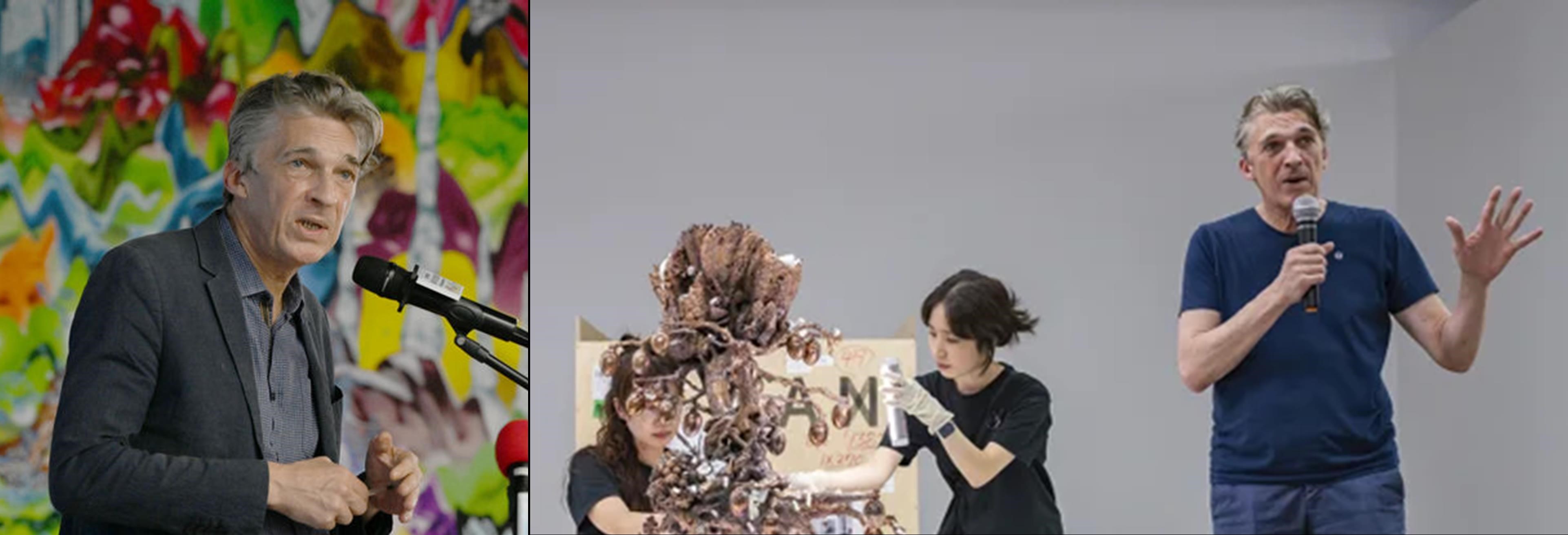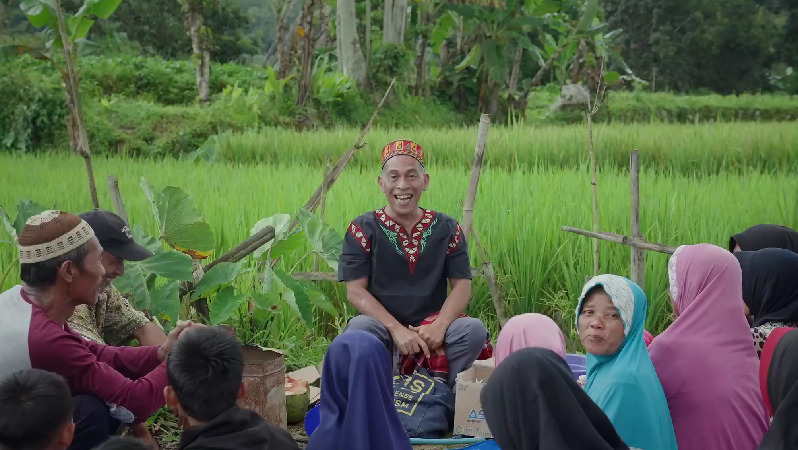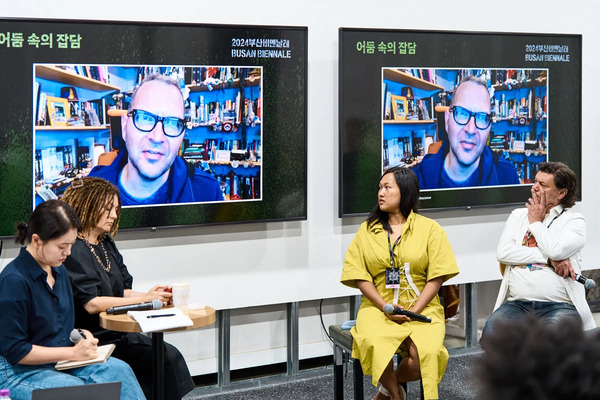 Posters from
the 1st to the 15th Gwangju Biennale (from left to right, clockwise), ⓒJeonnam
Ilbo.
Posters from
the 1st to the 15th Gwangju Biennale (from left to right, clockwise), ⓒJeonnam
Ilbo.The hot topic this year is the 30th anniversary of the
Gwangju Biennale. To commemorate this, we will take a look at its achievements,
divided into two parts. In Part 1, we will briefly review the history and
accomplishments of the Gwangju Biennale, and in Part 2, we will examine the
challenges it faces and its future prospects.
Since its establishment in 1995, the Gwangju Biennale
has firmly established itself as an essential art festival, raising the
international status of Korean contemporary art.
This year, celebrating its 30th anniversary, the 15th
Gwangju Biennale is being curated under the theme Pansori: Resonance for All.
It is directed by French curator Nicolas Bourriaud. The biennale aims to
reinterpret the traditional Korean art of pansori within the context of
contemporary art, focusing on sound and space to artistically address various
contemporary social issues.
In this article, we will provide a special overview of
the accomplishments and challenges that the Gwangju Biennale has encountered
over the past 30 years.
We will also discuss what is needed for Korean biennales
to further expand internationally and how they can continue to develop.
Specifically, we will focus on what is required for Korean biennales to firmly
establish themselves as world-class events.
 The opening
ceremony of the 1st Gwangju Biennale held in 1995. The exhibition, curated by
17 curators, featured 660 participating artists presenting a total of 1,228
works. Over the course of two months, the exhibition attracted 1.64 million
visitors, more than the population of Gwangju at the time. ⓒGwangju City Audiovisual Archives.
The opening
ceremony of the 1st Gwangju Biennale held in 1995. The exhibition, curated by
17 curators, featured 660 participating artists presenting a total of 1,228
works. Over the course of two months, the exhibition attracted 1.64 million
visitors, more than the population of Gwangju at the time. ⓒGwangju City Audiovisual Archives.30-Year Brief History of the Gwangju Biennale
The Gwangju Biennale has garnered global attention by combining social messages with artistic experimentation, rooted in the historical context of the Gwangju Democratic Uprising of May 18, 1980. The biennale plays a critical role in transforming the spirit of Korea’s democratization movement into a cultural value that is shared with the international art scene.
The 1st Gwangju Biennale (1995) – Lim Young-bang: ‘Beyond the Borders’
The first Gwangju Biennale in 1995, directed by Lim Young-bang, was held under the theme Beyond the Borders. Its message focused on forming a community that transcends national, ethnic, ideological, and religious boundaries. Unfortunately, the Gwangju Biennale website contains limited and inadequate records of early exhibitions and events, which is regrettable.
 (Left) Lim
Young-bang, Chairman of the Organizing Committee / (Right) Former President Kim
Dae-jung, who visited the 1st Gwangju Biennale on October 21, 1995, as the
leader of the National Congress for New Politics, viewing Nam June Paik's
‘Dolmen.’ ⓒGwangju Biennale.
(Left) Lim
Young-bang, Chairman of the Organizing Committee / (Right) Former President Kim
Dae-jung, who visited the 1st Gwangju Biennale on October 21, 1995, as the
leader of the National Congress for New Politics, viewing Nam June Paik's
‘Dolmen.’ ⓒGwangju Biennale.In the first biennale, 50 countries and 92 artists
participated, with Kcho from Cuba receiving the top prize for the work
Forgetting to Remember. According to the Gwangju Biennale’s website, domestic
curators such as art critic and former director of the National Museum of
Modern and Contemporary Art Oh Kwang-su, and prominent art historian Yoo
Hong-jun were part of the curatorial team, along with renowned international
curators such as Kathy Halbreich (former MoMA deputy director), Anda
Rottenberg, Jean de Loisy, and Clive Adams. Unfortunately, further detailed
exhibition records are missing, which we ask readers to understand.
Lim Young-bang (1929–2015) was a distinguished scholar
in Western art history, who significantly contributed to the development and
internationalization of modern Korean art. He studied philosophy and art
history at the University of Paris, and received a PhD for his research on
public murals. Lim taught at Seoul National University and produced many
students.
 Grand Prize-winning artwork of the 1st Gwangju Biennale(1995).
The original title of Kcho's work displayed at the Gwangju Biennale is
"Para olvidar" (translated as "To Forget" or "For
Those Who Have No Memory"). This piece involves a boat made of various
found materials, including bottles, to evoke themes of migration, memory, and
the struggle of island life in Cuba. ⓒ e-Video History Archive.
Grand Prize-winning artwork of the 1st Gwangju Biennale(1995).
The original title of Kcho's work displayed at the Gwangju Biennale is
"Para olvidar" (translated as "To Forget" or "For
Those Who Have No Memory"). This piece involves a boat made of various
found materials, including bottles, to evoke themes of migration, memory, and
the struggle of island life in Cuba. ⓒ e-Video History Archive.He served as the inaugural chairman of the Gwangju
Biennale (1995) and played a crucial role in establishing the Korean Pavilion
at the Venice Biennale. His major publications include works on the
Renaissance, medieval art iconography, and Baroque art.
Lim received
the French Ordre des Arts et des Lettres in 1996 and the Silver Crown Order of
Cultural Merit from Korea in 2006 for his contributions to the art world.
The 7th Gwangju Biennale (2008) – Okwui Enwezor: ‘Annual Report’
Okwui Enwezor explored the role of art in recording and reflecting political and social issues in modern society under the theme 'Annual Report.' He addressed social issues and demonstrated how art can communicate with the real world.

Exhibition view of the 7th Gwangju Biennale (2008) ©Tistory.
 (Left) Okwui Enwezor ⓒKorea Arts & Culture
Education Service / (Right) 2008 Gwangju Biennale opening scene ⓒGwangju
Biennale.
(Left) Okwui Enwezor ⓒKorea Arts & Culture
Education Service / (Right) 2008 Gwangju Biennale opening scene ⓒGwangju
Biennale.Okwui Enwezor (1963–2019) was a Nigerian-born curator who played a pivotal role in bringing non-Western art to the global stage, curating significant exhibitions such as the Venice Biennale (2015) and Documenta in Kassel (2002). He served as the director of the Haus der Kunst in Munich from 2011 to 2018.
The 8th Gwangju Biennale (2010) – Massimiliano Gioni: ‘Maninbo’

2010 Gwangju Biennale exhibition view ⓒYonhap News
Massimiliano Gioni curated the 8th
Gwangju Biennale under the theme Maninbo, focusing on
individual lives and experiences.
Maninbo (translated as Ten Thousand
Lives) is a monumental literary project by renowned Korean poet Ko Un,
consisting of thirty volumes. The series was inspired by Ko Un's experiences
during the Korean War and his time in prison, where he vowed to write about the
lives of ordinary people he had encountered. Each volume contains numerous
poems, each dedicated to a different individual, often reflecting the
hardships, emotions, and struggles of common people.
The title Maninbo represents the
notion of documenting the stories of "ten thousand" people, though
the number is symbolic, referring to the vastness of human experiences rather
than a literal count. Through this, he successfully connected and reinterpreted
Korean themes within an international context. The exhibition was considered an
important attempt to explore personal narratives and global issues through art.
 (Left) Massimiliano Gioni, Artistic
Director ⓒYonhap News / (Right) Massimiliano Gioni holding Idesa Hendeles’ Partner
at the Gwangju Biennale ⓒNewsis
(Left) Massimiliano Gioni, Artistic
Director ⓒYonhap News / (Right) Massimiliano Gioni holding Idesa Hendeles’ Partner
at the Gwangju Biennale ⓒNewsisMassimiliano Gioni is currently the
Artistic Director of the New Museum in New York and also serves as the Director
of the Nicola Trussardi Foundation in Milan, Italy.
He was the Artistic Director of the
2013 Venice Biennale and, alongside Maurizio Cattelan, co-founded The Wrong
Gallery. The gallery, known for its satirical and provocative exhibitions,
became an iconic independent art space in New York. The two also expanded their
influence in the international art world by jointly running independent art
publications such as The Wrong Times and Charley.
The 10th Gwangju Biennale (2014) – Jessica Morgan: 'Burning Down the House'
Jessica Morgan curated the 10th Gwangju Biennale under the theme Burning Down the House, where she explored themes of destruction and creation by challenging existing systems and conventions.
 (Left) Jessica Morgan ⓒYonhap News /
(Right) 2014 Gwangju Biennale press conference. 'Burning Down the House'
ⓒOhmynews
(Left) Jessica Morgan ⓒYonhap News /
(Right) 2014 Gwangju Biennale press conference. 'Burning Down the House'
ⓒOhmynews 2014 Gwangju Biennale exhibition piece ‘The Procession’
ⓒYonhap News.
2014 Gwangju Biennale exhibition piece ‘The Procession’
ⓒYonhap News.More than 90% of the works presented
at the Gwangju Biennale were new creations, making this an innovative
exhibition aimed at resisting existing societal structures and exploring new
artistic possibilities.
Jessica Morgan has been the director
of the Dia Art Foundation in New York since 2015, contributing significantly to
revitalizing major art projects and collections at the foundation. Prior to
that, she worked as a curator at Tate Modern in London from 2002 to 2014,
serving as the international art curator from 2010 and playing a key role in
expanding Tate’s global collection.
The 11th Gwangju Biennale (2016) – Maria Lind: 'The Eighth Climate'
The 2016 Gwangju Biennale, under the theme The Eighth Climate, explored the intersection of climate change and art.

Gwangju Biennale Exhibition Hall (Scene of May Mothers doing yoga in Bik-van-der-Pol’s work installed in Exhibition Hall 3) ⓒGwangju Biennale.
 (Left) / (Right) Maria Lind at the 2016 Gwangju
Biennale press conference ⓒGwangju Biennale
(Left) / (Right) Maria Lind at the 2016 Gwangju
Biennale press conference ⓒGwangju BiennaleMaria Lind, born in Sweden in 1966, is
a globally recognized curator, critic, and educator who has held various
influential positions in contemporary art institutions.
Lind was the director of Tensta
Konsthall in Stockholm from 2011 to 2018, and she served as the artistic
director of the Gwangju Biennale in 2016. She also worked as the cultural
attaché at the Swedish Embassy in Moscow from 2020 to 2023. Currently, she is
the director of the Norrbotten Museum of Contemporary Art in Sweden and teaches
at various institutions such as the Oslo Art Academy.
 2016 Gwangju Biennale opening scene ⓒGwangju Biennale.
2016 Gwangju Biennale opening scene ⓒGwangju Biennale.The 14th Gwangju Biennale (2023) – Sook-Kyung Lee: 'Soft and Weak Like Water'
The theme of the 14th Gwangju Biennale, Soft and Weak Like Water, is derived from the Tao Te Ching Chapter 78, which states, “Nothing in the world is as soft and yielding as water, yet nothing can better overcome the hard and strong.” The biennale uses the metaphor of water as a source of transformation and recovery, imagining the earth as a place of resistance, coexistence, solidarity, and care.
 (Left) Sook-Kyung Lee, artistic
director / (Right) Opening ceremony of the 14th Gwangju Biennale ⓒGwangju
Biennale
(Left) Sook-Kyung Lee, artistic
director / (Right) Opening ceremony of the 14th Gwangju Biennale ⓒGwangju
BiennaleSook-Kyung Lee, the artistic director
of the 14th edition, explained that the theme focuses on water’s ability to
penetrate deeply into both individuals and collectives, offering direction and
alternative solutions to the complex realities we face. She added that by
viewing global issues through the concept of "entanglement," the
biennale examines the pressing challenges impacting both the earth and
humanity, with a focus on art as a response.
Lee began her career as a curator at
the National Museum of Modern and Contemporary Art in Korea before moving to
the UK, where she gained recognition as the Senior Curator of International Art
at Tate Modern in London. Since August 2023, she has served as the director of
the Whitworth Art Gallery in Manchester. Before this, from 2019, she led the
Tate Research Centre: Transnational, spearheading a research project exploring
new perspectives on global art history.

On the eve of the 14th Gwangju Biennale’s opening, a press preview featured works such as The Elephant Without a Nose by Eom Jung-sun. ⓒGwangju Maeil Newspaper.
The 15th Gwangju Biennale (2024) – Nicolas Bourriaud: 'Pansori: Resonance for All'
The theme of the 2024 Gwangju Biennale, Pansori: Resonance for All, reinterprets the traditional Korean art of pansori through a contemporary lens, addressing contemporary issues such as social distancing, separation, and conflict, using the concepts of “space” and “sound” as metaphors.
 (Left) Nicolas Bourriaud / (Right)
Nicolas Bourriaud explaining a work at the 15th Gwangju Biennale’s pre-opening
event on the 19th ⓒGwangju Biennale
(Left) Nicolas Bourriaud / (Right)
Nicolas Bourriaud explaining a work at the 15th Gwangju Biennale’s pre-opening
event on the 19th ⓒGwangju Biennale Sofya Skidan,
What do you call a weirdness that hasn’t quite come together?, 2019-2024.
Three-channel video install. ⓒGwangju
Biennale
Sofya Skidan,
What do you call a weirdness that hasn’t quite come together?, 2019-2024.
Three-channel video install. ⓒGwangju
BiennaleNicolas Bourriaud successfully
attempts to bridge the gap between tradition and modernity, as well as between
Korea and the global sphere, through his contemporary reinterpretation of the
traditional Korean art of pansori.
Nicolas Bourriaud,
born in France in 1965, is a curator and theorist who has played a significant
role in contemporary art. He is best known for co-founding and serving as the
co-director of the Palais de Tokyo in Paris from 1999 to 2006, where he
developed new exhibition formats for contemporary art.
Bourriaud is also known for his
concept of Relational Aesthetics, which has had a profound impact on
modern art discourse since the 1990s. This theory emphasizes the formation of
art through the interaction between the artwork and its audience, focusing on
art as a form of social interaction.
 Marguerite
Humeau, *stirs, 2024. Hand dyed upcycled silk organza, acrylic vessel
(containing: microbial ecosystem of cyanobacteria and other photosynthetic
microorganisms, mud collected from ancient pond Gungnamji, various local
sediments, dry leaves, egg yolks, fruit peels, particles from a
33-million-year-old stromatolite bacteria colony, two axolotls, filtration and
heating system, turbidity and pH sensors, LEDs synchronised to the daily path
of the sun), handblown glass bubbles with inclusions of biological and
synthetic filaments, ash, stainless steel, aluminium, copper, sensor-activated
speakers, multi channel sound work featuring percussion and voice., Dimensions
variable. Courtesy of Surface Horizon Ltd. Commissioned by the 15th Gwangju
Biennale. ⓒGwangju Biennale
Marguerite
Humeau, *stirs, 2024. Hand dyed upcycled silk organza, acrylic vessel
(containing: microbial ecosystem of cyanobacteria and other photosynthetic
microorganisms, mud collected from ancient pond Gungnamji, various local
sediments, dry leaves, egg yolks, fruit peels, particles from a
33-million-year-old stromatolite bacteria colony, two axolotls, filtration and
heating system, turbidity and pH sensors, LEDs synchronised to the daily path
of the sun), handblown glass bubbles with inclusions of biological and
synthetic filaments, ash, stainless steel, aluminium, copper, sensor-activated
speakers, multi channel sound work featuring percussion and voice., Dimensions
variable. Courtesy of Surface Horizon Ltd. Commissioned by the 15th Gwangju
Biennale. ⓒGwangju BiennaleBourriaud has held positions such as Gulbenkian
Contemporary Art Curator at Tate Britain, and in 2009, he curated
the Tate Triennial under the theme Altermodern. Additionally,
from 2011 to 2015, he was the director of the École Nationale Supérieure des
Beaux-Arts (ENSBA) in Paris, contributing to art education during his
tenure.
Currently, Nicolas Bourriaud is the
director of MoCo (Montpellier Contemporain), which oversees La
Panacée, the Montpellier School of Fine Arts, and the Museum of
Contemporary Art. He has curated various international biennales and
exhibitions, and in 2014, he served as the artistic director of the Taipei
Biennial.
Achievements of the Gwangju Biennale
Over the past 30 years, the Gwangju
Biennale has played a crucial role in advancing and internationalizing
contemporary Korean art. Each edition has featured prominent curators from both
Korea and abroad, exploring social, political, and cultural issues through
various forms of contemporary art such as installations, performances, and
video art. The biennale has become a platform for showcasing diverse trends in
contemporary art while pursuing artistic innovation.
One of the Gwangju Biennale’s key
achievements is its success in conveying socially relevant messages with a
distinctly Korean identity, which has helped propel Korean artists onto the
global stage. By merging traditional Korean elements with modern societal
issues, the Gwangju Biennale has garnered attention from the international art
community. In 2014, the online art platform Artnet ranked the Gwangju
Biennale among the Top 5 Biennales in the World, alongside prestigious
events such as the Venice Biennale, Documenta in Kassel, the Whitney Biennial
in New York, and Manifesta in Europe.
However, many biennales around the
world, including the Gwangju Biennale, are increasingly criticized for
repeating similar formats and lacking innovation. As a result, the influence
and impact of these events have somewhat diminished compared to earlier years.
In particular, various biennales held
in Korea have faced challenges in connecting with the public. These events
often focus too heavily on niche artistic discourse, making it difficult for
wider audiences to engage. This is not just an issue for the Gwangju Biennale
but for biennales around the world.
The Need for Change
Now is the time for Korean biennales
to reconsider their fundamental structure and seek new directions. Rather than
resting on past successes, the Gwangju Biennale must evolve to meet the
changing social and cultural needs of contemporary society. One way to do this
is by fostering deeper engagement with local communities, making the biennale
more than just an art exhibition and creating a space where residents can
actively participate. Art should not exist solely within the confines of the
art world but should connect with a wide range of audiences and integrate with
their everyday lives.
(To be continued in Part 2)
Jay Jongho Kim graduated from the Department of Art Theory at Hongik University and earned his master's degree in Art Planning from the same university. From 1996 to 2006, he worked as a curator at Gallery Seomi, planning director at CAIS Gallery, head of the curatorial research team at Art Center Nabi, director at Gallery Hyundai, and curator at Gana New York. From 2008 to 2017, he served as the executive director of Doosan Gallery Seoul & New York and Doosan Residency New York, introducing Korean contemporary artists to the local scene in New York. After returning to Korea in 2017, he worked as an art consultant, conducting art education, collection consulting, and various art projects. In 2021, he founded A Project Company and is currently running the platforms K-ARTNOW.COM and K-ARTIST.COM, which aim to promote Korean contemporary art on the global stage.
























